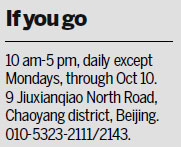

A new art museum opens in Beijing, backed by a banking enterprise. Deng Zhangyu reports.
Following a three-year preparation, Beijing Minsheng Art Museum opened to public viewing on Thursday with a large-scale inaugural exhibition featuring contemporary art by more than 100 Chinese artists.
Considered one of the country's biggest private art museums to date, about twice the size of the National Art Museum of China, Beijing Minsheng is spread over 35,000 square meters. The space was once used as a factory, like many other such art galleries near the 798 Art Zone, a landmark of the Chinese capital.
|
Beijing Minsheng Art Museum, one of the country's largest private museums, is open to the public with its inaugural show titled The Civil Power. Provided to China Daily |
The private museum has a shop, bookstore, cafe and warehouse for artwork storage. And the works of nearly 160 artists are on show - in a carnival-like atmosphere.
The silver box-like museum has been designed by Zhu Pei, an architect whose previous projects include working on an art pavilion with Guggenheim Foundation in Abu Dhabi.
Titled The Civil Power, Beijing Minsheng's inaugural exhibition has three sections: a competition section displaying 88 artworks selected from more than 8,000 pieces submitted by grassroots artists; an invitation section comprising 76 artists who have been active on the country's contemporary art scene over the past 30 years; and the fieldwork and art projects by four groups that spent months in rural China.
Guo Xiaoyan, deputy director of the new museum, says that they chose the artworks from the three decades since China's reform and opening-up, owing to the big changes that have taken place in the country.
Artists have also played a significant role in such changes and their creations reflect what they have documented, she says.
The exhibition's invitation section, for instance, has many works created in the 1980s and '90s. Examples are Shu Qun's A Cultural Pop Series on rock star Cui Jian and Zhang Wei's Loaders that uses a gray tone to represent the despair of workers at one time.
In the past two months, some 2 million Chinese voted online for the pieces of 32 artists on display in the competition section, with the museum providing 500,000 yuan ($80,600) in rewards for the prizes.
Beijing Minsheng is funded by China Minsheng Banking Group. Shanghai Minsheng Art Museum and M21, also in the country's financial capital, are two other museums backed by the same bank.

According to Beijing Minsheng director Zhou Xujun, the museum will focus on contemporary art after the 20th century. It will research the history of Chinese modern and contemporary art and introduce works by international artists from time to time. She says that a foundation will also be set up by the bank dedicated to art and culture.
In the past 20 years, China's private art museums faced a shortage of funds. Beijing Minsheng is also said to have struggled with finances initially and couldn't open to the public earlier.
But Zhou says she is optimistic about the future based on the Chinese economy.
A survey released by Development Forum of China Private Art Museum last year showed that private art museums make up one-third of all art museums in the country. Most of them are funded by real estate companies. So far, Minsheng museums are the only such art hubs supported by a Chinese bank, the survey says.
Wu Weishan, director of the National Art Museum of China, said at the opening ceremony of Beijing Minsheng that public museums and private museums are both important powers in driving China's culture development.
They should complement each other instead of trying to compete, Wu added.
The current Beijing Minsheng exhibition will run through Oct 10.
Contact the writer at dengzhangyu@chinadaily.com.cn
|
The Civil Power features artworks by both established and promising young artists. Deng Zhangyu / China Daily |